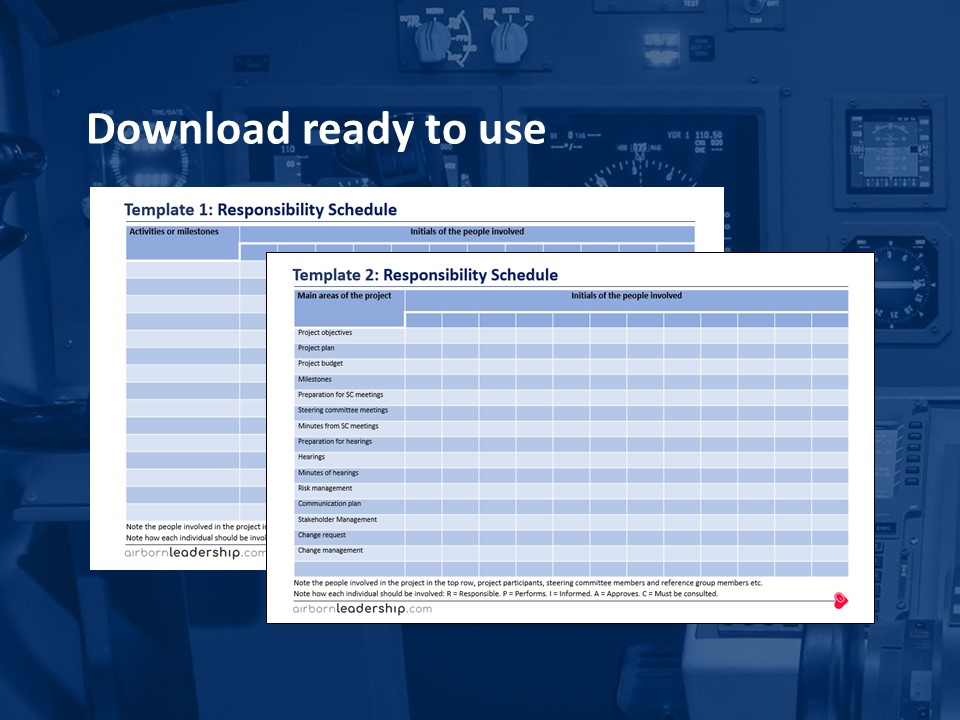
Responsibility Schedule
Download the tool and describe the participants’ responsibilities and involvement in detail so that it will be easy to communicate. Your resources are the project’s engine, they should ensure professional quality, decision-making competence and involvement of the “customers”. It is therefore important that the division of responsibility and the roles of each individual are lucidly described. The tool defines the involvement of key stakeholders regarding their responsibilities, whether they are performing, should be consulted, informed or endorsed by various activities or results.
Full description
Purpose and yield
The division of responsibility in the project has to ensure professional quality, decision-making competence and involvement of the “customers”. Projects are temporary and many participants have no prior knowledge of the different roles in the project, therefore it is important that the division of responsibility can be described in detail. The tool ensures that:
- Each individual’s responsibilities and roles are lucidly described.
- There is a relevant division of labor among the participants.
- An appropriate involvement in the project, such that there is a connection between the tasks and each individual’s responsibility.
- An appropriate task distribution that is easy to communicate.
When is the responsibility schedule used in the project?
- The responsibility schedule must be introduced as a tool at the start of the project when the project group is working on the plan for the project.
- The form is used continuously throughout the project and must often be updated when the project changes character.
- It is crucial that the form is used actively at the project team meetings.
Pitfalls and restrictions
- The tool doesn’t work if the project manager just works out the schedule by himself, saves it on his computer and doesn’t share it.
- The schedule is only effective if each individual participant knows the description and has accepted the roles.
- The description is a snapshot and should be continuously updated.
- The description should be carefully thought out. It will for example be a problem if more than one is responsible for the same task.
- Don’t put too many participants or stakeholders on “to be informed” or “to be consulted”.
Who should participate?
Agreements regarding the division of responsibilities and tasks should be made in a dialogue with the project participants. If the project manager does this alone, there is a high probability that the individual participant does not feel obligated by the description.
Approach
How to work with the form
- Think about the project and allocate the roles according to your best guess.
- Align your expectations with project owner, especially with regard to steering group and reference groups.
- Discuss the division of responsibilities at a meeting with your project team, so that the team knows the overall picture and has accepted their own role.
- If there are significant inconsistencies with a single team member, then discuss the division of responsibility during an individual meaning with the person in question.
- Inform stakeholders about their role in relation to the project and seek acceptance.
Template 1:
- Start by noting the initials in the dark blue fields below the bar with the text: Initials of the people involved.
- If there are too many people, multiple templates can be used. E.g. one template for the project team, one for the steering committee and one for the reference groups.
- The milestones or tasks that the participants must relate to are then noted in the left column. There may also be general themes as shown in template 2.
- Finally, note how the individual should be involved. Use the following letters next to each activity and under the different people: R = Responsible P = Performs I = Informed A = Approves C = Consulted.
- Check for each activity that all roles are marked: Responsible, performing, informed, approving and consulted.
- There may be more people performing and informing, but there should be only one responsible.
- Check whether the workload is reasonable under the individual employee, so that there aren’t just a few doing it all.
Template 2:
- This template has defined some main areas of the project to which the participants must relate. The template may be appropriate for members of the steering committee and reference groups but may be too inaccurate for the project team.
- Template 2 fills in the same way as template 1.
Detailed description in the PowerPoint tool
The detailed description of the approach and the general roles in the project organization are described in the PowerPoint tool. The Word tool contains only the templates. The tool is so general that it can be used even if you work according to the principles of IPMA, Prince2, PMI or agile methods such as Scrum or Half Double.




